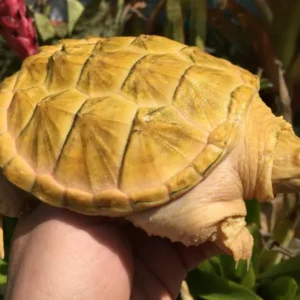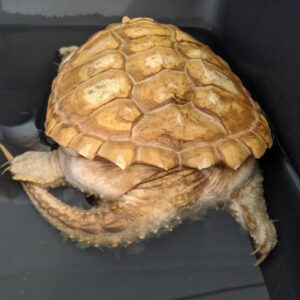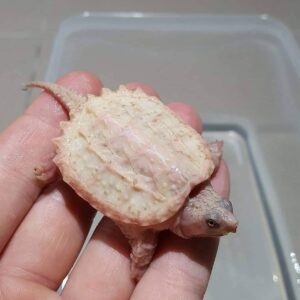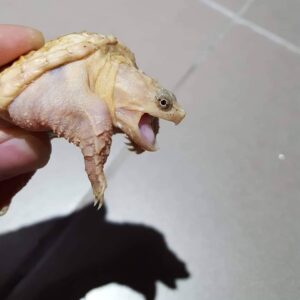Albino Pinkbelly Side-neck Turtle For Sale
$499.99
WE HAVE ALBINO PINKBELLY SIDE-NECK TURTLE FOR SALE. HERE ARE SOME HIGHLIGHTS:
- Emydura subglobosa
- Captive Bred
- Approximately 4 Inches In Shell Length
- Adults Are Averaging In Sizes From 8 – 12 Inches In Shell Length
- Feeding On Turtle Pellets, Crickets, Fish And Leafy Greens
FUN FACTS!
- These Babies Will Retain Their Beautiful Colors As They Mature
- Naturally Occurring Out Of The Islands Of Papua New Guinea
- Be Sure To Provide A Dry Basking Area To Rest From Swimming, A Heat Lamp And UVB Lighting
- With Proper Care These Reptiles Can Live 20 – 30 Years In Captivity
Description
The albino pinkbelly side-neck turtle, scientifically known as Emydura subglobosa, is a unique and captivating variant of the more common pinkbelly side-neck turtle. Originating from the freshwater rivers and swamps of Australia and New Guinea, this species is distinguished by its striking coloration and distinctive physical characteristics. The albino variant, in particular, stands out due to its lack of pigmentation, resulting in a pale, almost translucent shell and skin, accompanied by vibrant red or pink eyes. These features render the albino pinkbelly side-neck turtle a highly sought-after specimen among reptile enthusiasts and collectors.
What sets the albino pinkbelly side-neck turtle apart from its non-albino counterparts is its genetic mutation, which inhibits the production of melanin. This lack of melanin not only alters the turtle’s appearance but also affects its sensitivity to sunlight, making it more prone to the harmful effects of ultraviolet rays. As a result, albino pinkbelly side-neck turtles require special care and consideration, particularly in terms of their habitat and exposure to natural light.
Despite these challenges, the allure of the albino pinkbelly side-neck turtle lies in its rarity and the delicate beauty of its appearance. The soft pink hue of its underbelly and the almost ethereal quality of its shell make it a fascinating subject for both amateur and professional herpetologists. Additionally, the albino variant provides valuable insights into the study of genetic mutations and their impact on the physiology and behavior of reptiles.
In summary, the albino pinkbelly side-neck turtle is a remarkable example of nature’s diversity and the intricate interplay of genetics. Its unique characteristics and the specific care it requires make it an intriguing and rewarding species to study and keep. As we delve deeper into the fascinating world of these turtles, we will uncover the various aspects that contribute to their mystique and appeal.
Physical Characteristics
The albino pinkbelly side-neck turtle, a variant of the common pinkbelly side-neck turtle (Emydura subglobosa), exhibits distinct physical characteristics that set it apart from its non-albino counterparts. Albinism, a genetic condition characterized by a lack of melanin, significantly impacts their appearance, giving these turtles their unique coloration. Unlike the typical dark green or brown hue of the shell and skin found in non-albino varieties, albino pinkbelly side-neck turtles possess a pale, almost translucent shell and skin, often tinged with shades of pink and yellow. This distinctive coloration makes them highly noticeable and fascinating to enthusiasts and collectors alike.
The shell structure of albino pinkbelly side-neck turtles is similar to that of other side-neck turtles. Their carapace, or upper shell, is relatively flat and streamlined, aiding in their aquatic lifestyle. The plastron, or lower shell, is broad and provides additional protection to the turtle’s ventral side. Despite the unique coloration, the shell’s structural integrity remains consistent with non-albino variants, ensuring these turtles are well-equipped for their natural habitats.
In terms of size, albino pinkbelly side-neck turtles are comparable to their non-albino peers. Adult specimens typically reach lengths of 6 to 9 inches, with females generally being larger than males. The size and shape of their limbs and head remain consistent with those of the species, featuring webbed feet adapted for swimming and a side-necked posture that allows them to tuck their heads sideways under the edge of their shell for protection.
However, the absence of melanin in albino pinkbelly side-neck turtles can lead to certain health implications. The lack of pigmentation makes their skin and eyes more sensitive to sunlight, increasing the risk of sunburn and requiring careful management of their exposure to UV light. Additionally, their unique appearance can make them more susceptible to predators in the wild, necessitating a secure and controlled environment when kept in captivity.
Habitat and Natural Environment
The albino pinkbelly side-neck turtle, a unique and captivating reptile, thrives in specific natural habitats that cater to its physiological and ecological requirements. Originating from the freshwater environments of Australia and New Guinea, these turtles are typically found in slow-moving rivers, swamps, and lagoons. These habitats provide the necessary aquatic environment that supports their lifestyle and biological functions.
Water quality is a critical factor for the well-being of albino pinkbelly side-neck turtles. They thrive in clean, oxygen-rich water with minimal pollution. The ideal water temperature ranges between 75°F to 82°F (24°C to 28°C), which aligns with the warm climates of their native regions. Consistent water quality and temperature help maintain their health and facilitate proper growth and development.
Moreover, these turtles are ectothermic, relying on external sources to regulate their body temperature. Thus, they require a habitat that offers a balance of basking areas and shaded spots. Basking areas, typically consisting of sunlit rocks or logs, allow them to absorb necessary heat and UV rays, which are vital for their metabolic processes and shell health.
Vegetation plays a significant role in the habitat of albino pinkbelly side-neck turtles. Aquatic plants not only provide a source of food but also offer shelter and protection from predators. These turtles are omnivorous, feeding on a mix of plant matter, small aquatic creatures, and insects. The presence of diverse vegetation supports a rich and varied diet, ensuring their nutritional needs are met.
Geographically, the albino pinkbelly side-neck turtle is distributed across various regions in Australia and New Guinea. Their presence in these regions is attributed to the availability of optimal environmental conditions that support their survival and reproduction. Understanding the specific habitat requirements of these turtles is crucial for their conservation and for providing appropriate care in captivity.
Diet and Feeding Habits
Albino pinkbelly side-neck turtles possess unique dietary needs that are crucial for their health and longevity. In the wild, these turtles are omnivorous, consuming a varied diet that includes aquatic vegetation, small fish, insects, and crustaceans. Their diet is influenced by seasonal availability, with a higher intake of protein-rich foods during warmer months and more plant matter during cooler periods.
When caring for albino pinkbelly side-neck turtles in captivity, it is essential to replicate their natural diet as closely as possible to ensure their well-being. A balanced diet for these turtles should include a combination of high-quality commercial turtle pellets, fresh vegetables, and live or frozen protein sources. Recommended vegetables include leafy greens such as romaine lettuce, kale, and dandelion greens, as well as other vegetables like carrots and squash.
Protein sources are equally important and can be provided through feeder fish, earthworms, crickets, and shrimp. It is advisable to offer a variety of protein options to prevent dietary boredom and ensure a comprehensive nutrient intake. Additionally, occasional treats such as bloodworms or mealworms can be given, but these should not constitute a significant portion of the diet.
Feeding schedules for albino pinkbelly side-neck turtles should be established to promote healthy growth and prevent overfeeding. Juvenile turtles require daily feedings due to their rapid growth and higher metabolic rates. As they mature, feeding can be reduced to every other day. It is important to monitor the turtles’ weight and adjust feeding quantities accordingly, as obesity can lead to health issues.
Providing a calcium supplement is also crucial for these turtles, particularly for shell and bone health. This can be done by dusting food with a calcium powder or offering cuttlebone in their habitat. Ensuring that the albino pinkbelly side-neck turtles receive a well-rounded and appropriate diet will contribute significantly to their overall health and longevity in captivity.
Behavior and Temperament
Albino pinkbelly side-neck turtles exhibit a range of fascinating behaviors and temperaments that make them unique among turtle species. These turtles are known for their relatively sociable nature, often seen interacting not only with their own kind but also with other species in a shared habitat. While they are generally peaceful, they can display a degree of territoriality, especially during feeding times. This behavior is essential to note for those considering them as pets, as it may necessitate separate feeding areas to avoid conflicts.
In terms of activity levels, albino pinkbelly side-neck turtles are notably active and curious. They enjoy exploring their environment, often seen swimming energetically or basking under heat lamps. This active lifestyle highlights the importance of providing a spacious and enriching habitat, complete with hiding spots, basking areas, and clean water for swimming. Their inquisitive nature also means they can sometimes become bored in a monotonous environment, so regular habitat changes and the introduction of new objects can help in keeping them mentally stimulated.
Unique behaviors of these turtles include their distinctive side-necked posture, where they tuck their heads sideways under their shells rather than pulling them directly back. This behavior is not just a defining physical characteristic but also serves as a defensive mechanism against potential threats. Additionally, their albino coloration, while visually striking, means they are more sensitive to sunlight, necessitating careful management of their exposure to UV light to avoid skin damage.
As pets, albino pinkbelly side-neck turtles are generally suitable for dedicated and knowledgeable keepers. Their sociable and active nature can provide a rewarding experience for those willing to invest in their care. Potential owners should be prepared for the commitment of maintaining an appropriate environment and should be knowledgeable about their specific dietary and lighting needs to ensure their health and well-being.
Health and Common Issues
The health of albino pinkbelly side-neck turtles, like any other reptile, requires meticulous attention, especially given their unique genetic makeup. Albinism, characterized by a lack of melanin, can predispose these turtles to several health issues. One prominent concern is the increased sensitivity to ultraviolet (UV) light, which can lead to skin burns and eye damage if not properly managed. Owners should ensure that their albino turtles are not exposed to direct sunlight for extended periods and that their enclosures are equipped with UVB lighting suitable for albino reptiles.
In addition to UV sensitivity, these turtles are also vulnerable to common diseases that affect most reptiles. Respiratory infections are prevalent, often caused by improper humidity levels or suboptimal temperatures within their habitat. Symptoms to watch for include wheezing, nasal discharge, and lethargy. Prompt veterinary care is essential to address these issues effectively. Shell rot is another condition to be mindful of, manifesting as lesions or soft spots on the shell caused by fungal or bacterial infections. Regular inspection and maintaining a clean, dry environment can help prevent this ailment.
Genetic disorders associated with albinism may also arise, potentially affecting the turtle’s overall health and longevity. While genetic screening is not commonly performed in turtles, being aware of their predispositions can help owners take proactive measures. Feeding a balanced diet is crucial; albino pinkbelly side-neck turtles require a mix of leafy greens, aquatic plants, and protein sources like insects or commercial turtle pellets to meet their nutritional needs.
Preventive care is paramount in maintaining the health of these unique turtles. Regular veterinary check-ups, proper habitat setup, and a vigilant eye for any signs of illness can make a significant difference. Providing a stress-free environment, adequate UVB lighting, and a diet rich in essential nutrients will ensure that albino pinkbelly side-neck turtles thrive in captivity. With the right care, these fascinating creatures can lead healthy, fulfilling lives.
Breeding and Reproduction
The breeding habits and reproductive processes of albino pinkbelly side-neck turtles are a compelling aspect of their biology. These turtles exhibit specific mating behaviors that are crucial to understand for successful breeding in both wild and captive environments. Typically, the mating season for albino pinkbelly side-neck turtles occurs during the warmer months, which is when the turtles are most active. Males generally engage in a series of courtship rituals, which may include head bobbing and shell nudging, to attract females.
Nesting behavior is an essential part of the reproductive process. Female albino pinkbelly side-neck turtles seek out suitable sites to lay their eggs, often preferring sandy or soft soil near water sources. The nesting site is carefully selected to ensure optimal conditions for egg incubation. After selecting a site, the female digs a nest cavity where she deposits her clutch of eggs, which can range from a few to several dozen, depending on her size and health.
Egg incubation is another critical stage in the reproductive cycle. In the wild, the eggs are left to incubate naturally, relying on the ambient temperature and environmental conditions. In captivity, however, successful breeding of albino pinkbelly side-neck turtles requires careful management of incubation conditions. The eggs should be placed in an incubator set to a consistent temperature, generally between 82-86°F (28-30°C), with a humidity level of around 70-80%. These conditions help ensure that the eggs develop properly and hatch successfully.
For those interested in breeding albino pinkbelly side-neck turtles in captivity, it is crucial to replicate their natural environment as closely as possible. Providing a balanced diet, a stress-free habitat, and adequate nesting sites will increase the likelihood of successful breeding. Additionally, monitoring the health and behavior of the breeding pair can provide valuable insights into the reproductive process and help address any potential issues promptly.
Conservation and Ethical Considerations
The conservation status of albino pinkbelly side-neck turtles is a topic of rising concern among herpetologists and wildlife conservationists. As a variant of the Emydura subglobosa species, these turtles are native to freshwater habitats in New Guinea and northern Australia. Although the species itself is not currently classified as endangered, the unique albino morph faces specific challenges due to its rarity and distinctive appearance.
In their natural habitats, albino pinkbelly side-neck turtles are more vulnerable to predation due to their lack of camouflage. This increases the importance of habitat protection and the implementation of conservation strategies to ensure their survival. Habitat destruction, particularly from agricultural expansion and urban development, poses a significant threat to these turtles. Efforts to preserve wetlands and rivers are crucial for maintaining the ecosystems that support their populations.
From an ethical standpoint, keeping albino pinkbelly side-neck turtles as pets calls for responsible ownership and breeding practices. Prospective owners must be well-informed about the specific care requirements of these turtles, which include a controlled environment that mimics their natural habitat. Proper husbandry is essential to prevent health issues that could arise from inadequate living conditions.
Moreover, ethical breeding practices are paramount to prevent the exploitation of albino pinkbelly side-neck turtles for commercial gain. Breeders should prioritize the health and genetic diversity of their stock, avoiding inbreeding and ensuring that turtles are not subjected to stressful or harmful conditions. It is also imperative that pet owners acquire their turtles from reputable sources that adhere to ethical guidelines, thereby supporting conservation efforts rather than contributing to the depletion of wild populations.
In summary, the conservation and ethical considerations surrounding albino pinkbelly side-neck turtles are multifaceted. Protecting their natural habitats and promoting responsible pet ownership and breeding practices are vital steps in ensuring the well-being and longevity of this fascinating turtle variant.










